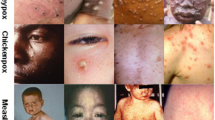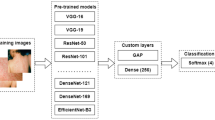Abstract
The world suffered a lot due to the Covid outbreak of 2019 which resulted into a pandemic and millions of people losing their lives and livelihoods as its repercussions. While the world was still recovering from its repercussions, the cases of monkeypox arose and were very evident in the US, Europe and Africa as well. The early detection of a disease plays a very vital role in curbing its spread. Foreseeing the Covid outbreak, in its early stages, its detection was very time-taking and hence late detection resulted in the spread of the disease. Therefore, we propose a CNN-based ensemble which exploits the feature extraction capabilities of VGG-16, MobileNet-50, Inception-V3 and ResNet-50 architectures. We thereby achieve a better ensemble accuracy of 90% using a large dataset. Along with the accuracy, we also aim at improving the recall, precision and f1-score in our ensemble learning method. We treat this problem to be a multiclass classification problem since detection of chickenpox, measles, cowpox, smallpox and healthy skin images can be often confusing and overlapping.
Access this chapter
Tax calculation will be finalised at checkout
Purchases are for personal use only
Similar content being viewed by others
References
Ahsan MM, Uddin MR, Farjana M, Sakib A, Momin K, Luna Shahana (2022) Image data collection and implementation of deep learning-based model in detecting Monkeypox disease using modified VGG16. https://doi.org/10.48550/arXiv.2206.01862
Moore M, Zahra F (2022) Monkeypox. https://www.ncbi.nlm.nih.gov/books/NBK574519/
McCollum AM, Damon IK (2014) Human monkeypox. Clin Infect Dis 58:260–267. https://doi.org/10.1093/cid/cit703
Okyay R, Bayrak E, Kaya E, Sahin A, Koçyiğit B, Tasdogan A, Avci A, Sumbul H (2022) Another epidemic in the shadow of Covid 19 pandemic: a review of Monkeypox. Eurasian J Med Oncol 6:95–99. https://doi.org/10.14744/ejmo.2022.2022
Kaler J, Hussain A, Flores G et al, Monkeypox: a comprehensive review of transmission, pathogenesis, and manifestation. Cureus 14(7):e26531. https://doi.org/10.7759/cureus.26531
2022 Global Map & Case Count (2022) https://www.cdc.gov/poxvirus/monkeypox/response/2022/world-map.html
Ardakani AB, Kanafi AR, Rajendra Acharya U, Khadem N, Mohammadi A (2020) Application of deep learning technique to manage COVID-19 in routine clinical practice using CT images: results of 10 convolutional neural networks. Comput Biol Med 121:103795. ISSN 0010-4825. https://doi.org/10.1016/j.compbiomed.2020.103795
Mangena V, Khamparia A, Gupta D, Pande S, Tiwari P, Hossain MS (2021) Res-CovNet: an internet of medical health things driven COVID-19 framework using transfer learning. Neural Comput Appl
Sitaula C, Basnet A, Mainali A, Shahi T (2021) Deep learning-based methods for sentiment analysis on Nepali COVID-19-related tweets. Comput Intell Neurosci. https://doi.org/10.1155/2021/2158184
Glock K, Napier C, Gary T, Gupta V, Gigante J, Schaffner W, Wang Q (2021) Measles rash identification using transfer learning and deep convolutional neural networks, 3905–3910. https://doi.org/10.1109/BigData52589.2021.9671333
Tan M, Le Quoc (2019) EfficientNet: rethinking model scaling for convolutional neural networks
Selvaraju RR, Cogswell M, Das A, Vedantam R, Parikh D, Batra D (2017) Grad-CAM: visual explanations from deep networks via gradient-based localization. IEEE Int Conf Comput Vis (ICCV) 2017:618–626. https://doi.org/10.1109/ICCV.2017.74
Ribeiro MT, Singh S, Guestrin C (2016) Why should I trust you?: explaining the predictions of any classifer. In: Proceedings of 78 Page 8 of 9 journal of medical systems (2022) 46:78 1 3the 22nd ACM SIGKDD international conference on knowledge discovery and data mining, San Francisco, CA, USA, August 13–17, 2016, pp 1135–1144
Abdelhamid A, El-kenawy E-S, Khodadadi N, Mirjalili S, Khafaga D, Alharbi A, Ibrahim A, Eid M, Saber M (2022) Classification of Monkeypox images based on transfer learning and the Al-Biruni earth radius optimization algorithm 10:3614. https://doi.org/10.3390/math10193614
Ali SN, Ahmed T, Paul J, Jahan T, Sani SM, Noor N, Hasan T (2022) Monkeypox skin lesion detection using deep learning models: a feasibility study. https://doi.org/10.48550/arXiv.2207.03342
Reyna MA, Kiarashi Y, Elola A, Oliveira J, Renna F, Gu A, Perez Alday EA, Sadr N, Sharma A, Kpodonu J, Mattos S, Coimbra MT, Sameni R, Rad AB, Clifford GD (2022) Heart murmur detection from phonocardiogram recordings: the George B. moody physionet challenge 2022. https://doi.org/10.1101/2022.08.11.22278688
Machine Learning and Knowledge Discovery in Databases (2021) Lecture notes in computer science. https://doi.org/10.1007/978-3-030-67658-2
Nivetha MN, Moulya MC, Parveen MA, Shree MR, Ragupathy MS (2020) Blood content prediction using deep learning techniques. Int J Innov Technol Explor Eng 9(6):308–313. https://doi.org/10.35940/ijitee.f3067.049620
Mohan S, Thirumalai CS, Srivastava G (2019) Effective heart disease prediction using hybrid machine learning techniques. IEEE Access 1–1. https://doi.org/10.1109/ACCESS.2019.2923707
Qin J, Chen L, Liu Y, Liu C, Feng C, Chen B (2020) A machine learning methodology for diagnosing chronic kidney disease. IEEE Access 8:20991–21002. https://doi.org/10.1109/ACCESS.2019.2963053
El-kenawy, E-S, Mirjalili S, Alassery F, Zhang Y-D, Eid M, El-Mashad S, Aloyaydi B, Ibrahim A, Abdelhamid A (2022) Novel meta-heuristic algorithm for feature selection, unconstrained functions and engineering problems. IEEE Access 1–1. https://doi.org/10.1109/ACCESS.2022.3166901
Deng J, Dong W, Socher R, Li L-J, Li K, Li F-F (2009) ImageNet: a large-scale hierarchical image database. In: IEEE conference on computer vision and pattern recognition, pp 248–255
Chollet F (2017) Xception: deep learning with depth wise separable convolutions. 1800–1807. https://doi.org/10.1109/CVPR.2017.195
Dwivedi M, Tiwari RG, Ujjwal N (2022) Deep learning methods for early detection of Monkeypox skin lesion. In: 2022 8th international conference on signal processing and communication (ICSC), Noida, India, 2022, pp 343–348. https://doi.org/10.1109/ICSC56524.2022.10009571
Haque ME, Ahmed MR, Nila RS, Islam S (2022) Human Monkeypox disease detection using deep learning and attention mechanisms. In: 2022 25th international conference on computer and information technology (ICCIT), Cox’s Bazar, Bangladesh, 2022, pp 1069–1073. https://doi.org/10.1109/ICCIT57492.2022.10
Shahyeez Ahamed B, Usha R, Sreenivasulu G (2022) A deep learning-based methodology for predicting monkey pox from skin sores. In: 2022 IEEE 2nd Mysore sub section international conference (MysuruCon), Mysuru, India, 2022, pp 1–6. https://doi.org/10.1109/MysuruCon55714.2022.9972746
Sharma S, Parmar M (2020) Heart diseases prediction using deep learning neural network model. Int J Innov Technol Explor Eng 9(3):2244–2248. https://doi.org/10.35940/ijitee.c9009.019320
Bansal M, Goyal A, Choudhary A (2022) A comparative analysis of K-nearest neighbour, genetic, support vector machine, decision tree, and long short term memory algorithms in machine learning. Decis Anal J 3:100071. ISSN 2772-6622, https://doi.org/10.1016/j.dajour.2022.100071, https://www.sciencedirect.com/science/article/pii/S2772662222000261
Bansal M, Priya (2020) Application layer protocols for internet of healthcare things (IoHT). In: 2020 Fourth international conference on inventive systems and control (ICISC), Coimbatore, India, 2020, pp 369–376. https://doi.org/10.1109/ICISC47916.2020.9171092
Bansal M, Sirpal V (2021) Fog computing-based internet of things and its applications in healthcare. J Phys Conf Ser 1916 012041
Bansal MP (2021) Performance comparison of MQTT and CoAP protocols in different simulation environments. In: Ranganathan G, Chen J, Rocha Á (eds) Inventive communication and computational technologies. Lecture notes in networks and systems, vol 145. Springer, Singapore. https://doi.org/10.1007/978-981-15-7345-3_47
Bansal MP (2022) Machine learning perspective in VLSI computer-aided design at different abstraction levels. In: Shakya S, Bestak R, Palanisamy R, Kamel KA (eds) Mobile computing and sustainable informatics. Lecture notes on data engineering and communications technologies, vol 68. Springer, Singapore. https://doi.org/10.1007/978-981-16-1866-6_6
Author information
Authors and Affiliations
Corresponding author
Editor information
Editors and Affiliations
Rights and permissions
Copyright information
© 2023 The Author(s), under exclusive license to Springer Nature Singapore Pte Ltd.
About this paper
Cite this paper
Bansal, M., Arora, R., Keshari, S., Panchal, S. (2023). Discerning Monkeypox from Other Viruses of the Poxviridae Family in a Deep Learning Paradigm. In: Swaroop, A., Polkowski, Z., Correia, S.D., Virdee, B. (eds) Proceedings of Data Analytics and Management. ICDAM 2023. Lecture Notes in Networks and Systems, vol 787. Springer, Singapore. https://doi.org/10.1007/978-981-99-6550-2_3
Download citation
DOI: https://doi.org/10.1007/978-981-99-6550-2_3
Published:
Publisher Name: Springer, Singapore
Print ISBN: 978-981-99-6549-6
Online ISBN: 978-981-99-6550-2
eBook Packages: Intelligent Technologies and RoboticsIntelligent Technologies and Robotics (R0)




